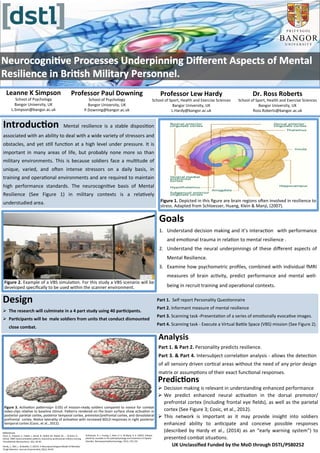
BPS Poster PhD Master Copy
- 1. P R I F Y S G O L BANGOR U N I V E R S I T Y Professor Paul Downing School of Psychology Bangor University, UK P.Downing@bangor.ac.uk Professor Lew Hardy School of Sport, Health and Exercise Sciences Bangor University, UK L.Hardy@bangor.ac.uk Dr. Ross Roberts School of Sport, Health and Exercise Sciences Bangor University, UK Ross.Roberts@bangor.ac.uk Leanne K Simpson School of Psychology Bangor University, UK L.Simpson@bangor.ac.uk Introduc>on Mental resilience is a stable disposiGon associated with an ability to deal with a wide variety of stressors and obstacles, and yet sGll funcGon at a high level under pressure. It is important in many areas of life, but probably none more so than military environments. This is because soldiers face a mulGtude of unique, varied, and oKen intense stressors on a daily basis, in training and operaGonal environments and are required to maintain high performance standards. The neurocogniGve basis of Mental Resilience (See Figure 1) in military contexts is a relaGvely understudied area. Goals 1. Understand decision making and it’s interacGon with performance and emoGonal trauma in relaGon to mental resilience . 2. Understand the neural underpinnings of these different aspects of Mental Resilience. 3. Examine how psychometric profiles, combined with individual fMRI measures of brain acGvity, predict performance and mental well-‐ being in recruit training and operaGonal contexts. Design Ø The research will culminate in a 4 part study using 40 par>cipants. Ø Par>cipants will be male soldiers from units that conduct dismounted close combat. Figure 2. Example of a VBS simulaGon. For this study a VBS scenario will be developed specifically to be used within the scanner environment. Analysis Part 1. & Part 2. Personality predicts resilience. Part 3. & Part 4. Intersubject correlaGon analysis -‐ allows the detecGon of all sensory driven corGcal areas without the need of any prior design matrix or assumpGons of their exact funcGonal responses. Figure 1. Depicted in this figure are brain regions oKen involved in resilience to stress. Adapted from Schloesser, Huang, Klein & Manji, (2007). Predic>ons Ø Decision making is relevant in understanding enhanced performance Ø We predict enhanced neural acGvaGon in the dorsal premotor/ prefrontal cortex (including frontal eye fields), as well as the parietal cortex (See Figure 3; Cosic, et al., 2012). Ø This network is important as it may provide insight into soldiers enhanced ability to anGcipate and conceive possible responses (described by Hardy et al., (2014) as an “early warning system”) to presented combat situaGons. UK Unclassified Funded by the MoD through DSTL/PS80252 Part 1. Self report Personality QuesGonnaire Part 2. Informant measure of mental resilience Part 3. Scanning task -‐PresentaGon of a series of emoGonally evocaGve images. Part 4. Scanning task -‐ Execute a Virtual Badle Space (VBS) mission (See Figure 2). Figure 3. AcGvaGon paderns(p< 0.05) of mission-‐ready soldiers compared to novice for combat video-‐clips relaGve to baseline sGmuli. Paderns rendered on the brain surface show acGvaGon in posterior parietal cortex, posterior temporal cortex, premotor/prefrontal cortex, and dorsolateral prefrontal cortex. NoGce laterality of acGvaGon with increased BOLD responses in right posterior temporal cortex (Cosic, et al., 2012). References Ćosić, K., Popović, S., Fabek, I., Kovač, B., Radoš, M., Radoš, M., ... & Šimić, G. (2012). fMRI neural acGvaGon paderns induced by professional military training. Transla'onal Neuroscience, 3(1), 46-‐50. Hardy, L., Bell, J., & Beaqe, S. (2014). A Neuropsychological Model of Mentally Tough Behavior. Journal of personality, 82(1), 69-‐81. Schloesser, R. J., Huang, J., Klein, P. S., & Manji, H. K. (2007). Cellular plasGcity cascades in the pathophysiology and treatment of bipolar disorder. Neuropsychopharmacology, 33(1), 110-‐133.
